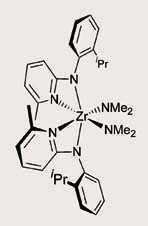Specially designed ligands are being called upon to try to control the chemistry of the maverick early transition metals (ETMs).

Peter Scott and his group at the University of Warwick, UK, are tackling a long-standing problem: making stereoselective ETM catalysts without having to use complicated ligands. Scott explains that usually in complexes of zirconium ’the ligands whiz about unpredictably’ causing problems for controlling stereochemistry. Their latest attempts at taming such complexes revealed that specially made arylaminopyridine ligands arrange themselves around zirconium according to the well-known ’trans influence’ rules.
What happens now is anyone’s guess, but it may clear the way for a whole host of new catalysts because, armed with this new knowledge, chemists might now be able to predict structures of ETM complexes. Scott remains pragmatic, saying ’we don’t know if the ligands (aminopyridines) will provide us with stellar catalysts’, but adds that ’it’s apparent now how we might be able to control the architecture in this type of complex so as to form chiral metal systems; this has important potential applications in enantioselective catalysis’.
Katharine Sanderson
References
E J Crust et al, Dalton Trans, 2004, 2257 <MAN>b407008a</MAN>






No comments yet